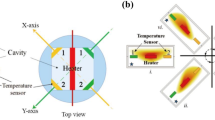Abstract
A method was presented for measuring the interior temperature of objects using a curved mercury capillary sensor based on X-ray radiography. The sensor is composed of a mercury bubble, a capillary and a fixed support. X-ray digital radiography was employed to capture image of the mercury column in the capillary, and a temperature control system was designed for the sensor calibration. We adopted livewire algorithms and mathematical morphology to calculate the mercury length. A measurement model relating mercury length to temperature was established, and the measurement uncertainty associated with the mercury column length and the linear model fitted by least-square method were analyzed. To verify the system, the interior temperature measurement of an autoclave, which is totally closed, was taken from 29.53 \({^{\circ }}\)C to 67.34 \({^{\circ }}\)C. The experiment results show that the response of the system is approximately linear with an uncertainty of maximum 0.79 \({^{\circ }}\)C. This technique provides a new approach to measure interior temperature of objects.








Similar content being viewed by others
References
D.L. BlackBurn, Temperature measurements of semiconductor devices-A review. in Annual IEEE Semiconductor Thermal Measurement and Management Symposium (San Jose, CA., United States, 2004), pp. 70–80
D. Werschmoeller, X. Li, J. Manuf. Processes 13, 147 (2011)
M.M. Werneck, R.C.S.B. Allil, B.A. Ribeiro, Fiber Bragg grating temperature sensing system for large air cooled hydrogenerators, in Fifth International Conference on Sensing Technology (Palmerston North, New Zealand, 2011), pp. 329–334
X. Li, G. Fei, W. Zhou et al., Solid State Commun. 150, 1117 (2010)
J.P. Schmidt, S. Arnold, A. Loges et al., J. Power Sources 243, 110 (2013)
G. Castanet, A. Labergue, F. Lemoine, Int. J. Therm. Sci. 50, 1181 (2011)
S.J. Norton, L.R. Testardi, H.N.G. Wadley, Clin. Radiol. 59, 255 (2004)
M. Huang, Z. Li, Y. Xia, Geo Spatial. Inf. Sci. 13, 150 (2012)
T.D. McGee, Principles and Methods of Temperature Measurement (Wiley, London, 1988)
A.X. Falcao, J.K. Udupa, S. Samarasekera et al., Graph Models Image Process. 60, 233 (1998)
W.A. Barrett, E.N. Mortensen, Med. Image Anal. 1, 331 (1997)
E.R. Dougherty, An Introduction to Morphological Image Processing (SPIE Optical Engineering Press, Bellingham, 1992)
Determination and use of straight-line calibration functions (Geneva, Switzerland, 2010), http://hsevi.ir/RI_Standard/File/8590. Accessed 1 Sept 2010
Acknowledgements
The work reported here was supported by the National Natural Science Foundation of China, under Grant 51176016.
Author information
Authors and Affiliations
Corresponding author
Rights and permissions
About this article
Cite this article
Chen, S., Jiang, X. & Lu, G. Interior Temperature Measurement Using Curved Mercury Capillary Sensor Based on X-ray Radiography. Int J Thermophys 38, 97 (2017). https://doi.org/10.1007/s10765-017-2230-x
Received:
Accepted:
Published:
DOI: https://doi.org/10.1007/s10765-017-2230-x




